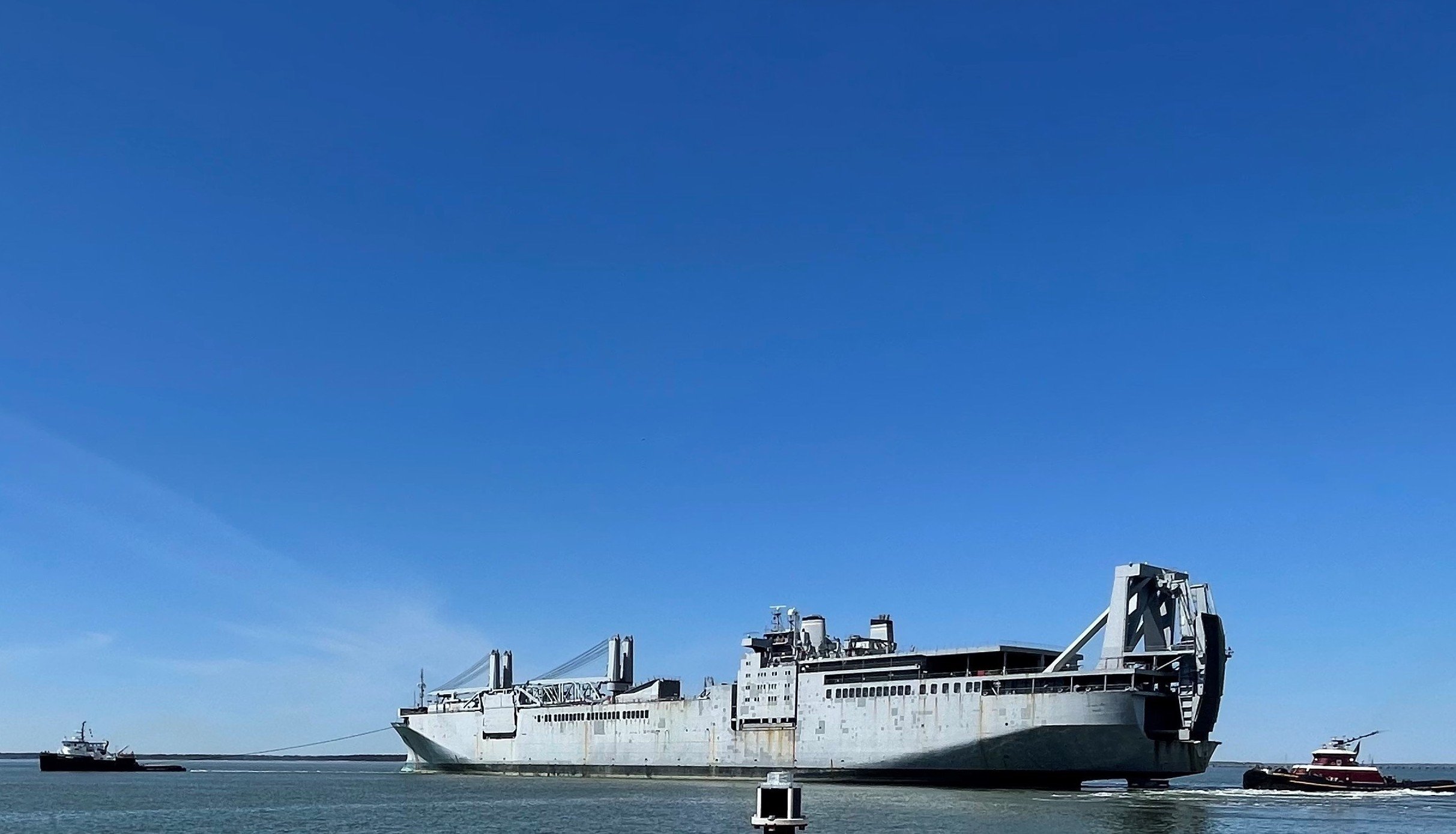Signet Warhorse II towed Military Sealift Command’s Large, Medium-Speed, Roll-on/Roll-off (LMSR) ship USNS Yano (T-AKR 297) from Newport News Marine Terminal in Newport News, Va., to the Maritime Administration Reserve Fleet in Beaumont, Texas, where the vessel will permanently join MARAD’s Ready Reserve Force (RRF). US Navy Photo
The head of the Maritime Administration “was not at all confident” that all the ships in the Ready Reserve Fleet could be crewed if called to duty in a crisis.
The United States was already short 1,8000 credentialed mariners for its vessels before the COVID-19 pandemic hit in 2020, retired Rear Adm. Ann Phillips said Tuesday in a joint hearing of the House Armed Services readiness and seapower and projection forces subcommittees.
She pointed to the addition of five more vessels transferred from Military Sealift Command to MARAD control and retirements of an aging workforce as likely pushing the gap for merchant mariners even higher.
While the House Armed Services Committee last year approved a grant program for MARAD to expand its Centers of Excellence program to attract and retrain mariners, there were no funds set aside to pay for it.
Phillips said programs like that are essential for the future, and MARAD is working closely with community colleges, union schools and others to demonstrate to young people there are careers open to them.
“We have to have ships for them to sail on,” she said.
But the questions facing MARAD is who does it have and if they will said, Phillips asked rhetorically. She referred both to the age of the ships in the fleet and the workforce. In her opening statement, she noted that the Ready Reserve Fleet is increasingly “difficult and challenging” to repair. Some of its vessels use propulsion systems that were retired decades ago in commercial shipping and exist in no other vessels.
At the same time, space for repair in the nation’s shipyards is at a premium with the Navy, Coast Guard, Army Corps of Engineers and commercial shippers needing dry dock work. USNI News reported four Puget Sound dry docks were pulled from service over concerns of their viability to survive major seismic event. Should there be a mention of the timeline to reopen here?
The nation is “a generation late” in modernizing its roll-on, roll-off ships critical to military sealift, Air Force Gen. Jacqueline Van Ovost, head of Transportation command, said. She and others noted the ships’ average age is 44, and 17 of them are over 50.
The remark caused Rep. Michael Waltz (R-Fla.), chairman of the readiness panel to say he saw “a red-light cluster” blinking.
The age and condition of the MARAD fleet “just screams out” for attention, Rep. Joe Courtney, D-R.I., and ranking member of the seapower panel, said, citing reports of problems in their readiness to supply Ukraine.
During her opening remarks, Waltz said the sealift fleet had concerning readiness rates in recent exercises.
Van Ovost said Transportation Command was analyzing the results of the 2022 Turbo Activation exercise and using better metrics so it would have more confidence in being able to assess the fleet’s readiness.
“We have not yet seen the return on investment” in various modernization efforts and reforms that followed after the 2019 exercise, Van Ovost said. Only 40 percent of the ships involved in the exercise were capable of being put to sea on short notice.
When asked, Van Ovost said that recapitalizing the Ready Reserve Fleet is on a schedule of buying two used vessels and modifying them for military use and also building would not be complete until 2032.
One way to speed construction would be follow the model used in Philadelphia to build Empire State VI for MARAD, Courtney said. In Philadelphia, there was a designated vessel construction manager whose duties were to keep the building on schedule and held to the fixed price.
Phillips confirmed the vessel is being delivered “on time and on budget.”
“Accelerating the recapitalization … will be very helpful,” Van Ovost said. It would also allow these ships to be ready to operate under cyber threat and in a contested environment.
Phillips said the first two used vessels – Cape Arundel and Cape Cortes — to begin modernizing the Ready Reserve Fleet have been made, and MARAD is moving ahead to buy three more starting in April. Both modified vessels were in the American roll-on/roll-off Carrier program and are being transferred from Defense Department control to MARAD in the Department of Transportation.
MARAD also will take possession of Empire State VI, its first National Security Multi-Mission vessel this year. Empire State will first see service as an up-to-date training ship for New York’s Maritime Academy, but can also serve in humanitarian and disaster relief missions. The next four will go to the other state maritime academies.
Phillips and Van Ovost said the Tanker Security Program to overcome shortfalls in fuel delivery and ensure access to U.S.-flagged vessels is progressing on schedule. Phillips expected to add “the next 10 vessels very shortly” and “go to 20 ships in 2024.”
Committee members repeatedly mentioned how important this was for dispersed operations in the Indo-Pacific and even more so now with the closing of the Red Hill Bulk Fuel Storage Facility in Hawaii. The bulk fuel storage facility – used by all services – was ordered closed following leakages into Oahu’s water system.
Van Ovost added the key to future readiness in the air and maritime transportation is “consistent funding [and] a budget on time,” so modernization programs can move along and the command and MARAD can launch new starts.
Continuing resolutions put tight controls on spending to previous year’s spending and even tighter restrictions whether to allow new program starts.











No comments:
Post a Comment
How did you like the post, leave a comment. I would appreciate hearing from you all. Best wishes from JC's Naval, Maritime and Military News